Recent Research Progress in Indophenine-Based-Functional Materials: Design, Synthesis, and Optoelectronic Applications
Abstract
:1. Introduction
2. Basic Background of Organic Electronic Devices and Assessment Parameters
3. Synthetic Tactics of π-Extended Quinoidal Acceptors
3.1. Recent Advances of Dicyanomethylene End-Capped π-Conjugated Small Molecules
3.2. Indandione Terminated π-Conjugated Small Molecules
3.3. Analogs of Thiele’s and Chichibabin’s Dyes
3.4. Synthesis of Indophenine Dyes and Oxindole End-Capped Quinoidal Molecules
3.5. Molecular and Electronic Structures of Oxindole Terminated Quinoidal Molecules: Electrochemical and Optical Properties
3.6. Crystal Packing of Indophenine Molecules with O⋯S Conformational Locks
3.7. Chemical Stability of Diradicals Based Quinoidal Molecules
4. Device Applications
4.1. Quinoidal-Based Materials for OFETs
4.1.1. OFET-Materials Based on Dicyanomethylene End-Capped Quinoidal Molecules (n-Type and Ambipolar)
4.1.2. OFET Performance of Polymers Developed as n-Type Channel Materials
4.1.3. OFET Devices Performance of Polymers Used in Transistor Applications (p-Type and Ambipolar)
4.2. Organic Diradical TE Materials
4.3. Quinoidal Semiconducting Materials for Photovoltaic Applications
5. Conclusions
Author Contributions
Funding
Institutional Review Board Statement
Informed Consent Statement
Data Availability Statement
Conflicts of Interest
References
- Takimiya, K.; Nakano, M. Thiophene-Fused Naphthalene Diimides: New Building Blocks for Electron Deficient π-Functional Materials. Bull. Chem. Soc. Jpn. 2018, 91, 121–140. [Google Scholar] [CrossRef] [Green Version]
- Fan, Y.W.; Liu, J.; Hu, W.P.; Liu, Y.Q.; Jiang, L. The effect of thickness on the optoelectronic properties of organic field-effect transistors: Towards molecular crystals at monolayer limit. J. Mater. Chem. C 2020, 8, 13154–13168. [Google Scholar] [CrossRef]
- Sirringhaus, H. 25th Anniversary Article: Organic Field-Effect Transistors: The Path Beyond Amorphous Silicon. Adv. Mater. 2014, 26, 1319–1335. [Google Scholar] [CrossRef] [PubMed] [Green Version]
- Li, H.; Brédas, J.-L. Developing molecular-level models for organic field-effect transistors. Natl. Sci. Rev. 2020. [Google Scholar] [CrossRef]
- Choi, J.; Gordon, M.P.; Yuan, P.; Kang, H.; Zaia, E.W.; Urban, J.J. CHAPTER 1 Introduction. In Organic Thermoelectric Materials; The Royal Society of Chemistry: London, UK, 2020; pp. 1–20. [Google Scholar]
- Russ, B.; Glaudell, A.; Urban, J.J.; Chabinyc, M.L.; Segalman, R.A. Organic thermoelectric materials for energy harvesting and temperature control. Nat. Rev. Mater. 2016, 1, 16050. [Google Scholar] [CrossRef]
- Zhang, J.; Tan, H.S.; Guo, X.; Facchetti, A.; Yan, H. Material insights and challenges for non-fullerene organic solar cells based on small molecular acceptors. Nat. Energy 2018, 3, 720–731. [Google Scholar] [CrossRef]
- Zhang, C.; Zhu, X.Z. n-Type Quinoidal Oligothiophene-Based Semiconductors for Thin-Film Transistors and Thermoelectrics. Adv. Funct. Mater. 2020, 30. [Google Scholar] [CrossRef]
- Sun, Y.L.; Guo, Y.L.; Liu, Y.Q. Design and synthesis of high performance pi-conjugated materials through antiaromaticity and quinoid strategy for organic field-effect transistors. Mater. Sci. Eng. R-Rep. 2019, 136, 13–26. [Google Scholar] [CrossRef]
- Casado, J. Para-Quinodimethanes: A Unified Review of the Quinoidal-Versus-Aromatic Competition and its Implications. Top. Curr. Chem. 2017, 375. [Google Scholar] [CrossRef]
- Huang, J.Y.; Yu, G. Recent progress in quinoidal semiconducting polymers: Structural evolution and insight. Mater. Chem. Front. 2021, 5, 76–96. [Google Scholar] [CrossRef]
- Li, G.; Matsuno, T.; Han, Y.; Wu, S.; Zou, Y.; Jiang, Q.; Isobe, H.; Wu, J. Fused Quinoidal Dithiophene-Based Helicenes: Synthesis by Intramolecular Radical–Radical Coupling Reactions and Dynamics of Interconversion of Enantiomers. Angew. Chem. Int. Ed. 2021, 60, 10326–10333. [Google Scholar] [CrossRef]
- Acker, D.S.; Harder, R.J.; Hertler, W.R.; Mahler, W.; Melby, L.R.; Benson, R.E.; Mochel, W.E. 7,7,8,8-tetracyanoquinodimethane and its electrically conducting anion-radical derivatives. J. Am. Chem. Soc. 1960, 82, 6408–6409. [Google Scholar] [CrossRef]
- Torrance, J.B. The difference between metallic and insulating salts of tetracyanoquinodimethone (TCNQ): How to design an organic metal. Acc. Chem. Res. 1979, 12, 79–86. [Google Scholar] [CrossRef]
- Uno, M.; Seto, K.; Takahashi, S. A new method of synthesis of arylmalononitriles catalysed by a palladium complex. J. Chem. Soc. Chem. Commun. 1984, 932–933. [Google Scholar] [CrossRef]
- Uno, M.; Seto, K.; Masuda, M.; Ueda, W.; Takahashi, S. A new route to phenylenedimalononitrile and the analogues using palladium-catalyzed carbon-carbon bond formation. Tetrahedron Lett. 1985, 26, 1553–1556. [Google Scholar] [CrossRef]
- Martín, N.; Segura, J.L.; Seoane, C. Design and synthesis of TCNQ and DCNQI type electron acceptor molecules as precursors for ‘organic metals’. J. Mater. Chem. 1997, 7, 1661–1676. [Google Scholar] [CrossRef]
- Takimiya, K.; Kawabata, K. Thienoquinoidal System: Promising Molecular Architecture for Optoelectronic Applications. J. Synth. Org. Chem. Jpn. 2018, 76, 1176–1184. [Google Scholar] [CrossRef] [Green Version]
- Lu, J.; Dadvand, A.; Chu, T.-y.; Movileanu, R.; Baribeau, J.-M.; Ding, J.; Tao, Y. Inkjet-printed unipolar n-type transistors on polymer substrates based on dicyanomethylene-substituted diketopyrrolopyrrole quinoidal compounds. Org. Electron. 2018, 63, 267–275. [Google Scholar] [CrossRef]
- Qiao, Y.; Guo, Y.; Yu, C.; Zhang, F.; Xu, W.; Liu, Y.; Zhu, D. Diketopyrrolopyrrole-Containing Quinoidal Small Molecules for High-Performance, Air-Stable, and Solution-Processable n-Channel Organic Field-Effect Transistors. J. Am. Chem. Soc. 2012, 134, 4084–4087. [Google Scholar] [CrossRef]
- Jiang, H.; Oniwa, K.; Xu, Z.; Bao, M.; Yamamoto, Y.; Jin, T. Synthesis and Properties of Dicyanomethylene-Endcapped Thienopyrrole-Based Quinoidal S,N-Heteroacenes. Bull. Chem. Soc. Jpn. 2017, 90, 789–797. [Google Scholar] [CrossRef]
- Joseph, V.; Yu, C.-H.; Lin, C.-C.; Lien, W.-C.; Tsai, H.-C.; Chen, C.-S.; Torimtubun, A.A.A.; Velusamy, A.; Huang, P.-Y.; Lee, G.-H.; et al. Quinoidal thioalkyl-substituted bithiophene small molecule semiconductors for n-type organic field effect transistors. J. Mater. Chem. C 2020, 8, 15450–15458. [Google Scholar] [CrossRef]
- Canesi, E.V.; Fazzi, D.; Colella, L.; Bertarelli, C.; Castiglioni, C. Tuning the Quinoid versus Biradicaloid Character of Thiophene-Based Heteroquaterphenoquinones by Means of Functional Groups. J. Am. Chem. Soc. 2012, 134, 19070–19083. [Google Scholar] [CrossRef] [PubMed]
- Badía-Domínguez, I.; Peña-Álvarez, M.; Wang, D.; Pérez Guardiola, A.; Vida, Y.; Rodríguez González, S.; López Navarrete, J.T.; Hernández Jolín, V.; Sancho García, J.C.; García Baonza, V.; et al. Dynamic Covalent Properties of a Novel Indolo[3,2-b]carbazole Diradical. Chem.—A Eur. J. 2021, 27, 5509–5520. [Google Scholar] [CrossRef] [PubMed]
- Yamamoto, K.; Jinnai, S.; Takehara, T.; Suzuki, T.; Ie, Y. Quinoidal Oligothiophenes Having Full Benzene Annelation: Synthesis, Properties, Structures, and Acceptor Application in Organic Photovoltaics. Org. Lett. 2020, 22, 547–551. [Google Scholar] [CrossRef]
- Velusamy, A.; Yu, C.-H.; Afraj, S.N.; Lin, C.-C.; Lo, W.-Y.; Yeh, C.-J.; Wu, Y.-W.; Hsieh, H.-C.; Chen, J.; Lee, G.-H.; et al. Thienoisoindigo (TII)-Based Quinoidal Small Molecules for High-Performance n-Type Organic Field Effect Transistors. Adv. Sci. 2021, 8, 2002930. [Google Scholar] [CrossRef]
- Du, T.; Gao, R.; Deng, Y.; Wang, C.; Zhou, Q.; Geng, Y. Indandione-Terminated Quinoids: Facile Synthesis by Alkoxide-Mediated Rearrangement Reaction and Semiconducting Properties. Angew. Chem. Int. Ed. 2020, 59, 221–225. [Google Scholar] [CrossRef]
- Yang, M.; Du, T.; Zhao, X.; Huang, X.; Pan, L.; Pang, S.; Tang, H.; Peng, Z.; Ye, L.; Deng, Y.; et al. Low-bandgap conjugated polymers based on benzodipyrrolidone with reliable unipolar electron mobility exceeding 1 cm2 V−1 s−1. Sci. China Chem. 2021, 64, 1219–1227. [Google Scholar] [CrossRef]
- Montgomery, L.K.; Huffman, J.C.; Jurczak, E.A.; Grendze, M.P. The molecular structures of Thiele’s and Chichibabin’s hydrocarbons. J. Am. Chem. Soc. 1986, 108, 6004–6011. [Google Scholar] [CrossRef] [PubMed]
- Ishii, A.; Horikawa, Y.; Takaki, I.; Shibata, J.; Nakayama, J.; Hoshino, M. Preparation of 2,5-bis(diarylmethylene)-2,5-dihydrothiophenes and their furan, selenophene, and N-methylpyrrole analogs. Tetrahedron Lett. 1991, 32, 4313–4316. [Google Scholar] [CrossRef]
- Takeda, T.; Akutagawa, T. Preparation, Structure, and Redox Behavior of Bis(diarylmethylene)dihydrothiophene and Its π-Extended Analogues. J. Org. Chem. 2015, 80, 2455–2461. [Google Scholar] [CrossRef]
- Mazaki, Y.; Murata, S.; Kobayashi, K. Thermal and photochemical formation of quinonoid derivatives of condensed polythiophenes and their spectral properties. Tetrahedron Lett. 1991, 32, 4367–4370. [Google Scholar] [CrossRef]
- Wang, K.; Li, Z.; Huang, J.; Wang, T.; Gao, J.; Gao, Y.; Wang, S.; He, S.; Lv, A.; Wang, M. Design and synthesis of two conjugated semiconductors containing quinoidal cyclopentadithiophene core. Dye. Pigment. 2021, 190, 109336. [Google Scholar] [CrossRef]
- Jiménez, V.G.; Mayorga-Burrezo, P.; Blanco, V.; Lloveras, V.; Gómez-García, C.J.; Šolomek, T.; Cuerva, J.M.; Veciana, J.; Campaña, A.G. Dibenzocycloheptatriene as end-group of Thiele and tetrabenzo-Chichibabin hydrocarbons. Chem. Commun. 2020, 56, 12813–12816. [Google Scholar] [CrossRef]
- Baeyer, A. Untersuchungen über die Gruppe des Indigblaus. Ber. Der Dtsch. Chem. Ges. 1879, 12, 1309–1319. [Google Scholar] [CrossRef]
- Meyer, V. Ueber Benzole verschiedenen Ursprungs. Ber. Der Dtsch. Chem. Ges. 1882, 15, 2893–2894. [Google Scholar] [CrossRef]
- Tormos, G.V.; Belmore, K.A.; Cava, M.P. The indophenine reaction revisited. Properties of a soluble dialkyl derivative. J. Am. Chem. Soc. 1993, 115, 11512–11515. [Google Scholar] [CrossRef]
- Hwang, H.; Khim, D.; Yun, J.M.; Jung, E.; Jang, S.Y.; Jang, Y.H.; Noh, Y.Y.; Kim, D.Y. Quinoidal molecules as a new class of ambipolar semiconductor originating from amphoteric redox behavior. Adv. Funct. Mater. 2015, 25, 1146–1156. [Google Scholar] [CrossRef]
- Kim, Y.; Hwang, H.; Kim, N.K.; Hwang, K.; Park, J.J.; Shin, G.I.; Kim, D.Y. pi-Conjugated Polymers Incorporating a Novel Planar Quinoid Building Block with Extended Delocalization and High Charge Carrier Mobility. Adv. Mater. 2018, 30, 1706557. [Google Scholar] [CrossRef] [PubMed]
- Kim, Y.; Kim, Y.J.; Kim, Y.A.; Jung, E.; Mok, Y.; Kim, K.; Hwang, H.; Park, J.J.; Kim, M.G.; Mathur, S.; et al. Open-Shell and Closed-Shell Quinoid-Aromatic Conjugated Polymers: Unusual Spin Magnetic and High Charge Transport Properties. ACS Appl. Mater. Interfaces 2021, 13, 2887–2898. [Google Scholar] [CrossRef]
- Jiang, H.; Hu, Q.; Cai, J.; Cui, Z.; Zheng, J.; Chen, W. Synthesis and dyeing properties of indophenine dyes for polyester fabrics. Dye. Pigment. 2019, 166, 130–139. [Google Scholar] [CrossRef]
- Cai, J.; Jiang, H.; Chen, W.; Cui, Z. Design, synthesis, characterization of water-soluble indophenine dyes and their application for dyeing of wool, silk and nylon fabrics. Dye. Pigment. 2020, 179. [Google Scholar] [CrossRef]
- Bhanvadia, V.J.; Choudhury, A.; Iyer, P.K.; Zade, S.S.; Patel, A.L. Constructing fused bis-isatins from pyrroloindoles using direct oxidation approach and re-visiting indophenine reaction. Polymer 2020, 210. [Google Scholar] [CrossRef]
- Guo, K.; Wu, B.; Jiang, Y.; Wang, Z.; Liang, Z.; Li, Y.; Deng, Y.; Geng, Y. Synthesis of an isomerically pure thienoquinoid for unipolar n-type conjugated polymers: Effect of backbone curvature on charge transport performance. J. Mater. Chem. C 2019, 7, 10352–10359. [Google Scholar] [CrossRef]
- Ren, L.; Fan, H.; Huang, D.; Yuan, D.; Di, C.-A.; Zhu, X. Dithienoindophenines: p-Type Semiconductors Designed by Quinoid Stabilization for Solar-Cell Applications. Chem.—A Eur. J. 2016, 22, 17136–17140. [Google Scholar] [CrossRef]
- Deng, Y.; Sun, B.; He, Y.; Quinn, J.; Guo, C.; Li, Y. Thiophene-S, S-dioxidized Indophenine: A Quinoid-Type Building Block with High Electron Affinity for Constructing n-Type Polymer Semiconductors with Narrow Band Gaps. Angew. Chem. Int. Ed. 2016, 55, 3459–3462. [Google Scholar] [CrossRef] [PubMed]
- Deng, Y.; Quinn, J.; Sun, B.; He, Y.; Ellard, J.; Li, Y. Thiophene-S, S-dioxidized indophenine (IDTO) based donor–acceptor polymers for n-channel organic thin film transistors. RSC Adv. 2016, 6, 34849–34854. [Google Scholar] [CrossRef]
- Hu, Q.; Jiang, H.; Cui, Z.; Chen, W. An insight into the effect of S, S-dioxided thiophene on the opto-physical/electro-chemical properties and light stability for indophenine derivatives. Dye. Pigment. 2020, 173, 107891. [Google Scholar] [CrossRef]
- Deng, Y.; Sun, B.; Quinn, J.; He, Y.; Ellard, J.; Guo, C.; Li, Y. Thiophene-S, S-dioxidized indophenines as high performance n-type organic semiconductors for thin film transistors. RSC Adv. 2016, 6, 45410–45418. [Google Scholar] [CrossRef]
- Gao, R.; Wu, B.; Liang, Z.; Zhao, X.; Deng, Y.; Tian, H.; Geng, Y. Electronic properties modulation of tetraoxidothieno[3,2-b]thiophene-based quinoidal compounds by terminal fluorination. Mater. Chem. Front. 2020, 4, 891–898. [Google Scholar] [CrossRef]
- Lin, L.; Wang, C.; Deng, Y.; Geng, Y. Isomerically Pure Oxindole-Terminated Quinoids for n-Type Organic Thin-Film Transistors Enabled by the Chlorination of Quinoidal Core. Chem.—A Eur. J. 2022, e202203336. [Google Scholar] [CrossRef] [PubMed]
- Pappenfus, T.M.; Helmin, A.J.; Wilcox, W.D.; Severson, S.M.; Janzen, D.E. ProDOT-Assisted Isomerically Pure Indophenines. J. Org. Chem. 2019, 84, 11253–11257. [Google Scholar] [CrossRef] [PubMed]
- Hwang, K.; Lee, M.-H.; Kim, J.; Kim, Y.-J.; Kim, Y.; Hwang, H.; Kim, I.-B.; Kim, D.-Y. 3,4-Ethylenedioxythiophene-Based Isomer-Free Quinoidal Building Block and Conjugated Polymers for Organic Field-Effect Transistors. Macromolecules 2020, 53, 1977–1987. [Google Scholar] [CrossRef]
- Kim, Y.; Choi, Y.; Hwang, H.; Kang, M.; Hwang, K.; Lee, M.-H.; Kim, D.-Y. Isomer-Free Quinoidal Conjugated Polymers with Different Core Lengths for Organic Field-Effect Transistors. ACS Appl. Polym. Mater. 2022, 4, 8520–8526. [Google Scholar] [CrossRef]
- Choi, Y.; Kim, Y.; Moon, Y.; Kim, I.-B.; Hwang, H.; Kim, D.-Y. Significant alternation of molecular structures and properties in quinoidal conjugated polymers by chalcogen atom substitution. J. Mater. Chem. C 2022, 10, 17874–17885. [Google Scholar] [CrossRef]
- Sun, Y.; Zhang, Y.; Ran, Y.; Shi, L.; Zhang, Q.; Chen, J.; Li, Q.; Guo, Y.; Liu, Y. Methoxylation of quinoidal bithiophene as a single regioisomer building block for narrow-bandgap conjugated polymers and high-performance organic field-effect transistors. J. Mater. Chem. C 2020, 8, 15168–15174. [Google Scholar] [CrossRef]
- Ren, S.; Habibi, A.; Ni, P.; Nahdi, H.; Bouanis, F.Z.; Bourcier, S.; Clavier, G.; Frigoli, M.; Yassar, A. Synthesis and characterization of solution-processed indophenine derivatives for function as a hole transport layer for perovskite solar cells. Dye. Pigment. 2023, 111136. [Google Scholar] [CrossRef]
- Raimundo, J.-M.; Blanchard, P.; Frère, P.; Mercier, N.; Ledoux-Rak, I.; Hierle, R.; Roncali, J. Push–pull chromophores based on 2,2′-bi(3,4-ethylenedioxythiophene) (BEDOT) π-conjugating spacer. Tetrahedron Lett. 2001, 42, 1507–1510. [Google Scholar] [CrossRef]
- Zeng, Z.; Shi, X.; Chi, C.; López Navarrete, J.T.; Casado, J.; Wu, J. Pro-aromatic and anti-aromatic π-conjugated molecules: An irresistible wish to be diradicals. Chem. Soc. Rev. 2015, 44, 6578–6596. [Google Scholar] [CrossRef]
- Dressler, J.J.; Haley, M.M. Learning how to fine-tune diradical properties by structure refinement. J. Phys. Org. Chem. 2020, 33, e4114. [Google Scholar] [CrossRef]
- Das, S.; Wu, J. Polycyclic Hydrocarbons with an Open-Shell Ground State. Phys. Sci. Rev. 2017, 2. [Google Scholar] [CrossRef]
- Jiang, Q.; Han, Y.; Zou, Y.; Phan, H.; Yuan, L.; Herng, T.S.; Ding, J.; Chi, C. S-shaped para-Quinodimethane-Embedded Double [6]Helicene and Its Charged Species Showing Open-Shell Diradical Character. Chem.—A Eur. J. 2020, 26, 15613–15622. [Google Scholar] [CrossRef]
- Zhang, C.; Medina Rivero, S.; Liu, W.; Casanova, D.; Zhu, X.; Casado, J. Stable Cross-Conjugated Tetrathiophene Diradical. Angew. Chem. Int. Ed. 2019, 58, 11291–11295. [Google Scholar] [CrossRef]
- Shimizu, A.; Kishi, R.; Nakano, M.; Shiomi, D.; Sato, K.; Takui, T.; Hisaki, I.; Miyata, M.; Tobe, Y. Indeno[2,1-b]fluorene: A 20-π-Electron Hydrocarbon with Very Low-Energy Light Absorption. Angew. Chem. Int. Ed. 2013, 52, 6076–6079. [Google Scholar] [CrossRef] [PubMed]
- Ponce Ortiz, R.; Casado, J.; Hernández, V.; López Navarrete, J.T.; Viruela, P.M.; Ortí, E.; Takimiya, K.; Otsubo, T. On the Biradicaloid Nature of Long Quinoidal Oligothiophenes: Experimental Evidence Guided by Theoretical Studies. Angew. Chem. Int. Ed. 2007, 46, 9057–9061. [Google Scholar] [CrossRef] [PubMed]
- Kato, K.; Osuka, A. Platforms for Stable Carbon-Centered Radicals. Angew. Chem. Int. Ed. 2019, 58, 8978–8986. [Google Scholar] [CrossRef] [PubMed]
- Zafra, J.L.; Qiu, L.; Yanai, N.; Mori, T.; Nakano, M.; Alvarez, M.P.; Navarrete, J.T.L.; Gómez-García, C.J.; Kertesz, M.; Takimiya, K.; et al. Reversible Dimerization and Polymerization of a Janus Diradical To Produce Labile C−C Bonds and Large Chromic Effects. Angew. Chem. Int. Ed. 2016, 55, 14563–14568. [Google Scholar] [CrossRef] [Green Version]
- Morita, Y.; Suzuki, S.; Sato, K.; Takui, T. Synthetic organic spin chemistry for structurally well-defined open-shell graphene fragments. Nat. Chem. 2011, 3, 197–204. [Google Scholar] [CrossRef]
- Shimizu, A.; Hirao, Y.; Matsumoto, K.; Kurata, H.; Kubo, T.; Uruichi, M.; Yakushi, K. Aromaticity and pi-bond covalency: Prominent intermolecular covalent bonding interaction of a Kekule hydrocarbon with very significant singlet biradical character. Chem. Commun. 2012, 48, 5629–5631. [Google Scholar] [CrossRef]
- Tian, Y.; Uchida, K.; Kurata, H.; Hirao, Y.; Nishiuchi, T.; Kubo, T. Design and Synthesis of New Stable Fluorenyl-Based Radicals. J. Am. Chem. Soc. 2014, 136, 12784–12793. [Google Scholar] [CrossRef]
- Abe, M. Diradicals. Chem. Rev. 2013, 113, 7011–7088. [Google Scholar] [CrossRef]
- Pappenfus, T.M.; Chesterfield, R.J.; Frisbie, C.D.; Mann, K.R.; Casado, J.; Raff, J.D.; Miller, L.L. A π-Stacking Terthiophene-Based Quinodimethane Is an n-Channel Conductor in a Thin Film Transistor. J. Am. Chem. Soc. 2002, 124, 4184–4185. [Google Scholar] [CrossRef]
- Chesterfield, R.J.; Newman, C.R.; Pappenfus, T.M.; Ewbank, P.C.; Haukaas, M.H.; Mann, K.R.; Miller, L.L.; Frisbie, C.D. High Electron Mobility and Ambipolar Transport in Organic Thin-Film Transistors Based on a π-Stacking Quinoidal Terthiophene. Adv. Mater. 2003, 15, 1278–1282. [Google Scholar] [CrossRef]
- Gao, X.; Hu, Y. Development of n-type organic semiconductors for thin film transistors: A viewpoint of molecular design. J. Mater. Chem. C 2014, 2, 3099–3117. [Google Scholar] [CrossRef]
- Tsukamoto, K.; Takagi, K.; Nagano, S.; Hara, M.; Ie, Y.; Osakada, K.; Takeuchi, D. π-Extension of electron-accepting dithiarubicene with a cyano-substituted electron-withdrawing group and application in air-stable n-channel organic field effect transistors. J. Mater. Chem. C 2019, 7, 12610–12618. [Google Scholar] [CrossRef]
- Ren, L.; Yuan, D.; Zhu, X. Design of a Quinoidal Thieno[3,4-b]thiophene-Diketopyrrolopyrrole-Based Small Molecule as n-Type Semiconductor. Chem.—Asian J. 2019, 14, 1717–1722. [Google Scholar] [CrossRef]
- Yamamoto, K.; Kato, S.-i.; Zajaczkowska, H.; Marszalek, T.; Blom, P.W.M.; Ie, Y. Effects of fluorine substitution in quinoidal oligothiophenes for use as organic semiconductors. J. Mater. Chem. C 2020, 8, 3580–3588. [Google Scholar] [CrossRef]
- Lin, Z.; Chen, L.; Xu, Q.; Shao, G.; Zeng, Z.; Wu, D.; Xia, J. Tuning Biradical Character to Enable High and Balanced Ambipolar Charge Transport in a Quinoidal π-System. Org. Lett. 2020, 22, 2553–2558. [Google Scholar] [CrossRef]
- Huang, J.; Lu, S.; Chen, P.-A.; Wang, K.; Hu, Y.; Liang, Y.; Wang, M.; Reichmanis, E. Rational Design of a Narrow-Bandgap Conjugated Polymer Using the Quinoidal Thieno[3,2-b]thiophene-Based Building Block for Organic Field-Effect Transistor Applications. Macromolecules 2019, 52, 4749–4756. [Google Scholar] [CrossRef]
- Hwang, H.; Kim, Y.; Kang, M.; Lee, M.-H.; Heo, Y.-J.; Kim, D.-Y. A conjugated polymer with high planarity and extended π-electron delocalization via a quinoid structure prepared by short synthetic steps. Polym. Chem. 2017, 8, 361–365. [Google Scholar] [CrossRef]
- Kim, Y.; Yang, D.; Kim, Y.-J.; Jung, E.; Park, J.-J.; Choi, Y.; Kim, Y.; Mathur, S.; Kim, D.-Y. Azaquinoid-Based High Spin Open-Shell Conjugated Polymer for n-Type Organic Field-Effect Transistors. Adv. Mater. Interfaces 2022, 2201205. [Google Scholar] [CrossRef]
- Zhu, Z.; Wang, L.; Gao, C. Chapter 3—Thermoelectric properties of PEDOTs. In Advanced PEDOT Thermoelectric Materials; Jiang, F., Liu, C., Xu, J., Eds.; Woodhead Publishing: Cambridge, UK, 2022; pp. 73–95. [Google Scholar]
- Lu, Y.; Yu, Z.-D.; Un, H.-I.; Yao, Z.-F.; You, H.-Y.; Jin, W.; Li, L.; Wang, Z.-Y.; Dong, B.-W.; Barlow, S.; et al. Persistent Conjugated Backbone and Disordered Lamellar Packing Impart Polymers with Efficient n-Doping and High Conductivities. Adv. Mater. 2021, 33, 2005946. [Google Scholar] [CrossRef]
- Sun, Y.; Di, C.A.; Xu, W.; Zhu, D.B. Advances in n-Type Organic Thermoelectric Materials and Devices. Adv. Electron. Mater. 2019, 5. [Google Scholar] [CrossRef]
- Tripathi, A.; Lee, Y.; Lee, S.; Woo, H.Y. Recent advances in n-type organic thermoelectric materials, dopants, and doping strategies. J. Mater. Chem. C 2022, 10, 6114–6140. [Google Scholar] [CrossRef]
- Zhao, X.; Madan, D.; Cheng, Y.; Zhou, J.; Li, H.; Thon, S.M.; Bragg, A.E.; DeCoster, M.E.; Hopkins, P.E.; Katz, H.E. High Conductivity and Electron-Transfer Validation in an n-Type Fluoride-Anion-Doped Polymer for Thermoelectrics in Air. Adv. Mater. 2017, 29, 1606928. [Google Scholar] [CrossRef]
- Yuan, D.; Huang, D.; Rivero, S.M.; Carreras, A.; Zhang, C.; Zou, Y.; Jiao, X.; McNeill, C.R.; Zhu, X.; Di, C.-A.; et al. Cholesteric Aggregation at the Quinoidal-to-Diradical Border Enabled Stable n-Doped Conductor. Chem 2019, 5, 964–976. [Google Scholar] [CrossRef] [Green Version]
- Yuan, D.; Guo, Y.; Zeng, Y.; Fan, Q.; Wang, J.; Yi, Y.; Zhu, X. Air-Stable n-Type Thermoelectric Materials Enabled by Organic Diradicaloids. Angew. Chem. Int. Ed. 2019, 58, 4958–4962. [Google Scholar] [CrossRef] [PubMed]
- Liu, W.; Li, W.; Yao, J.; Zhan, C. Achieving high short-circuit current and fill-factor via increasing quinoidal character on nonfullerene small molecule acceptor. Chin. Chem. Lett. 2018, 29, 381–384. [Google Scholar] [CrossRef]





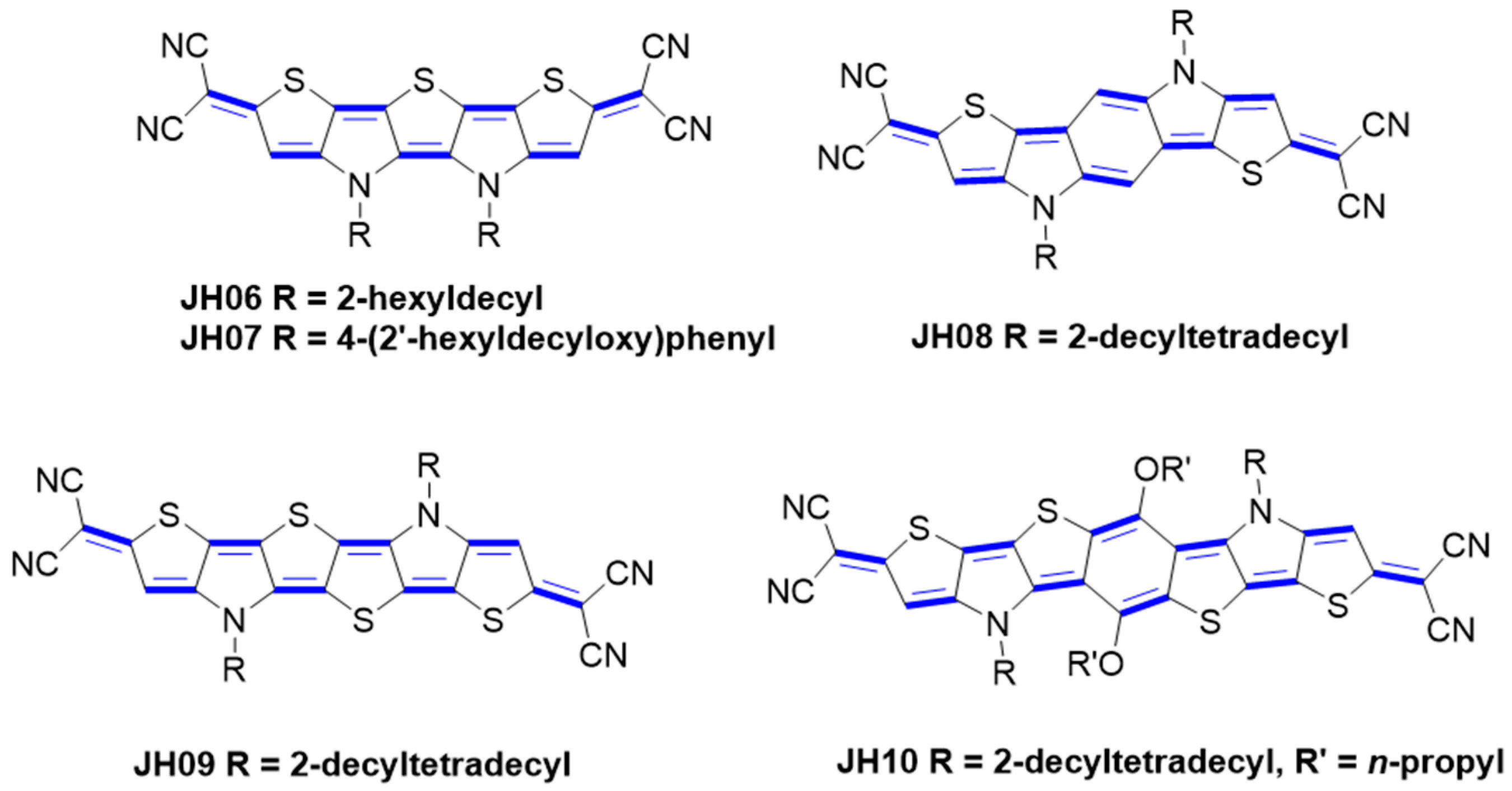




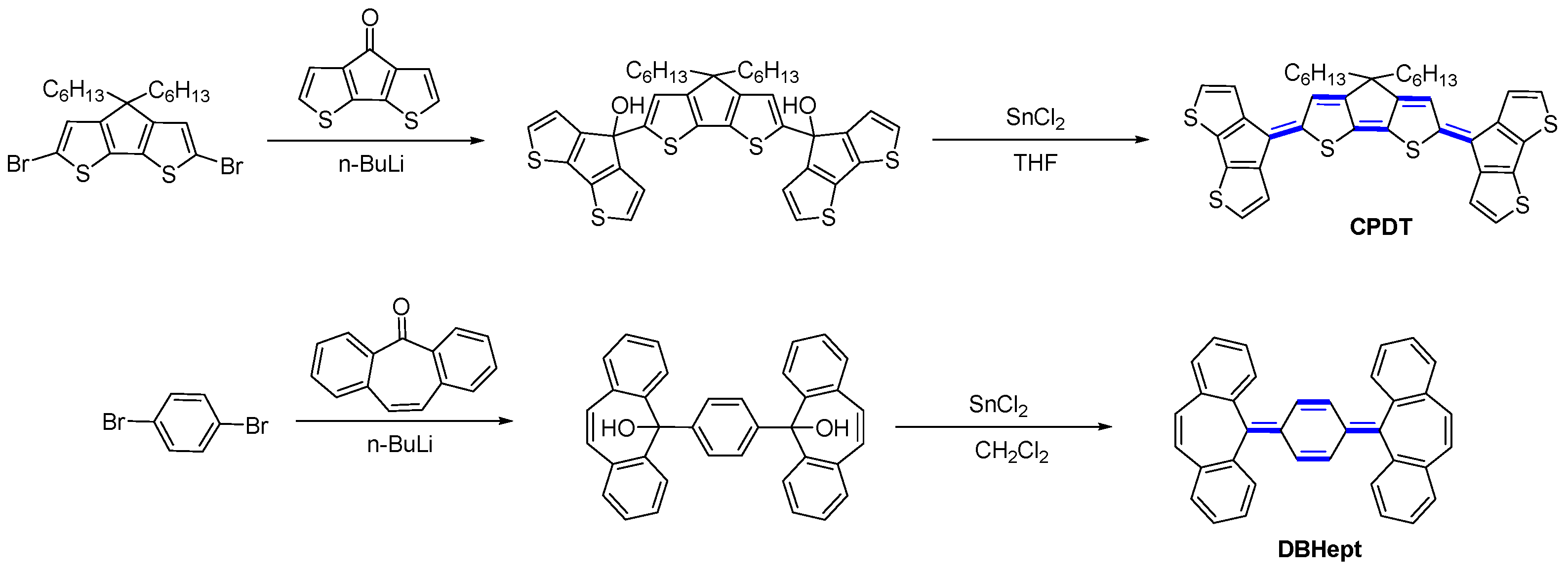
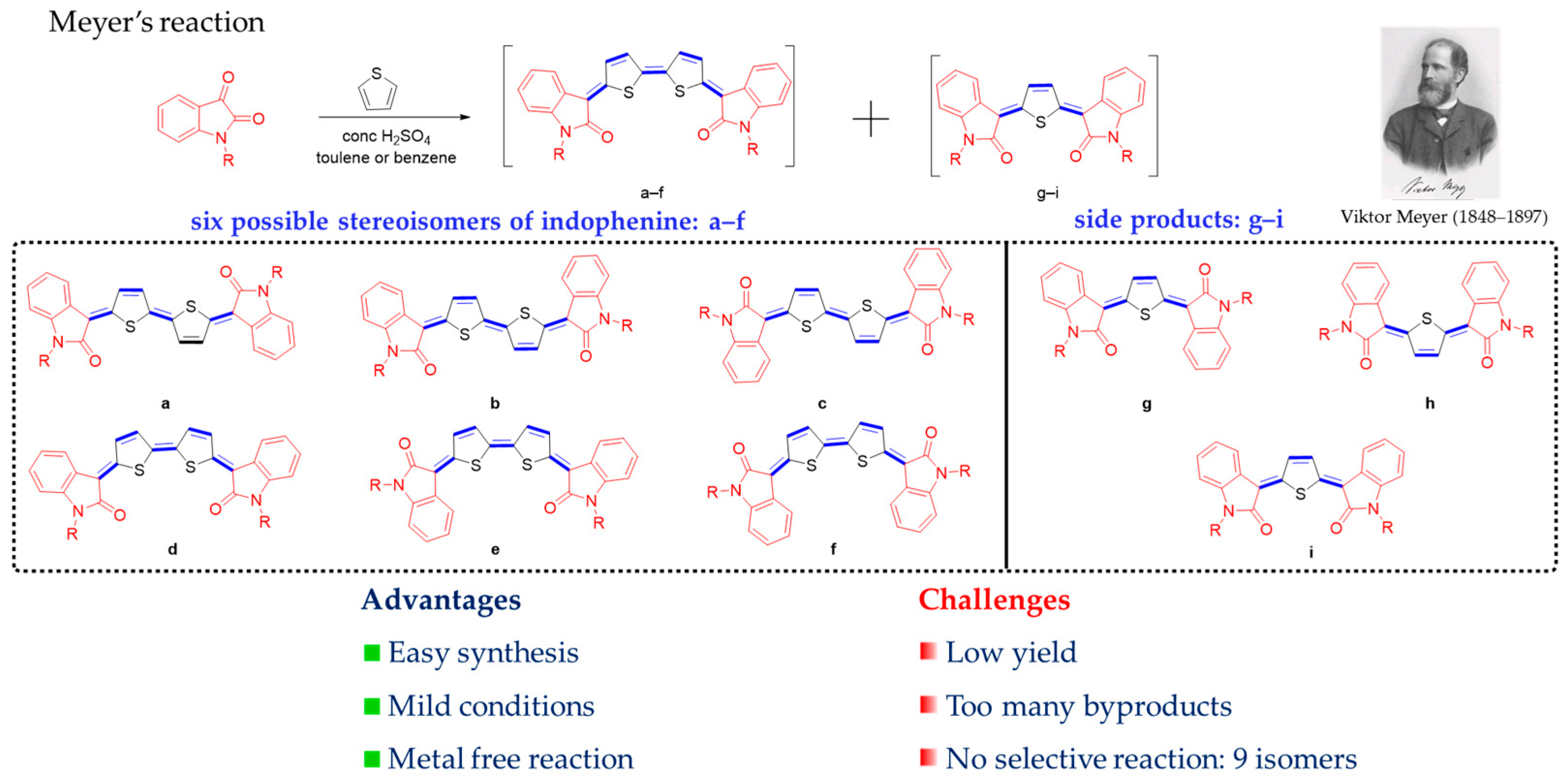
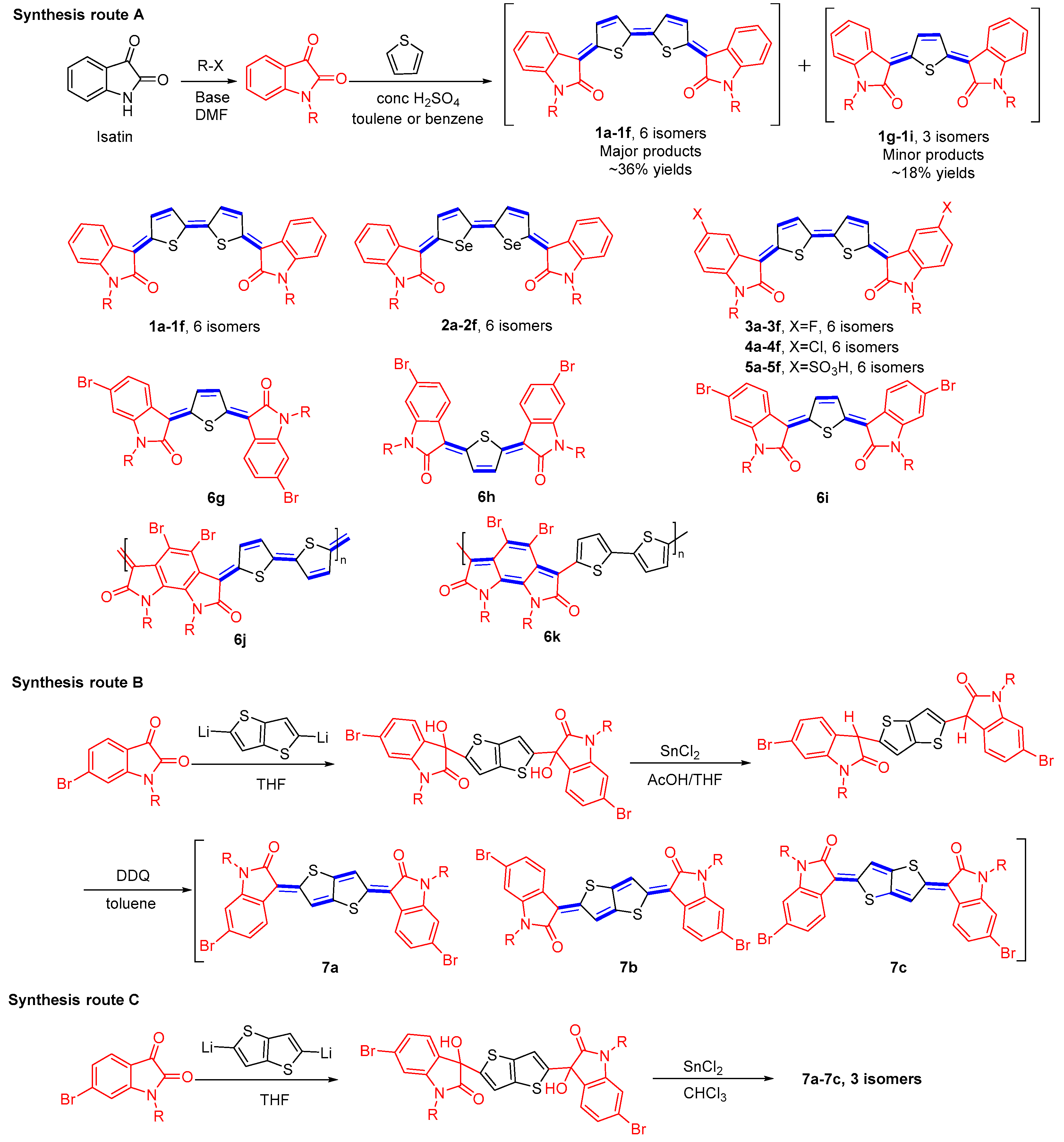
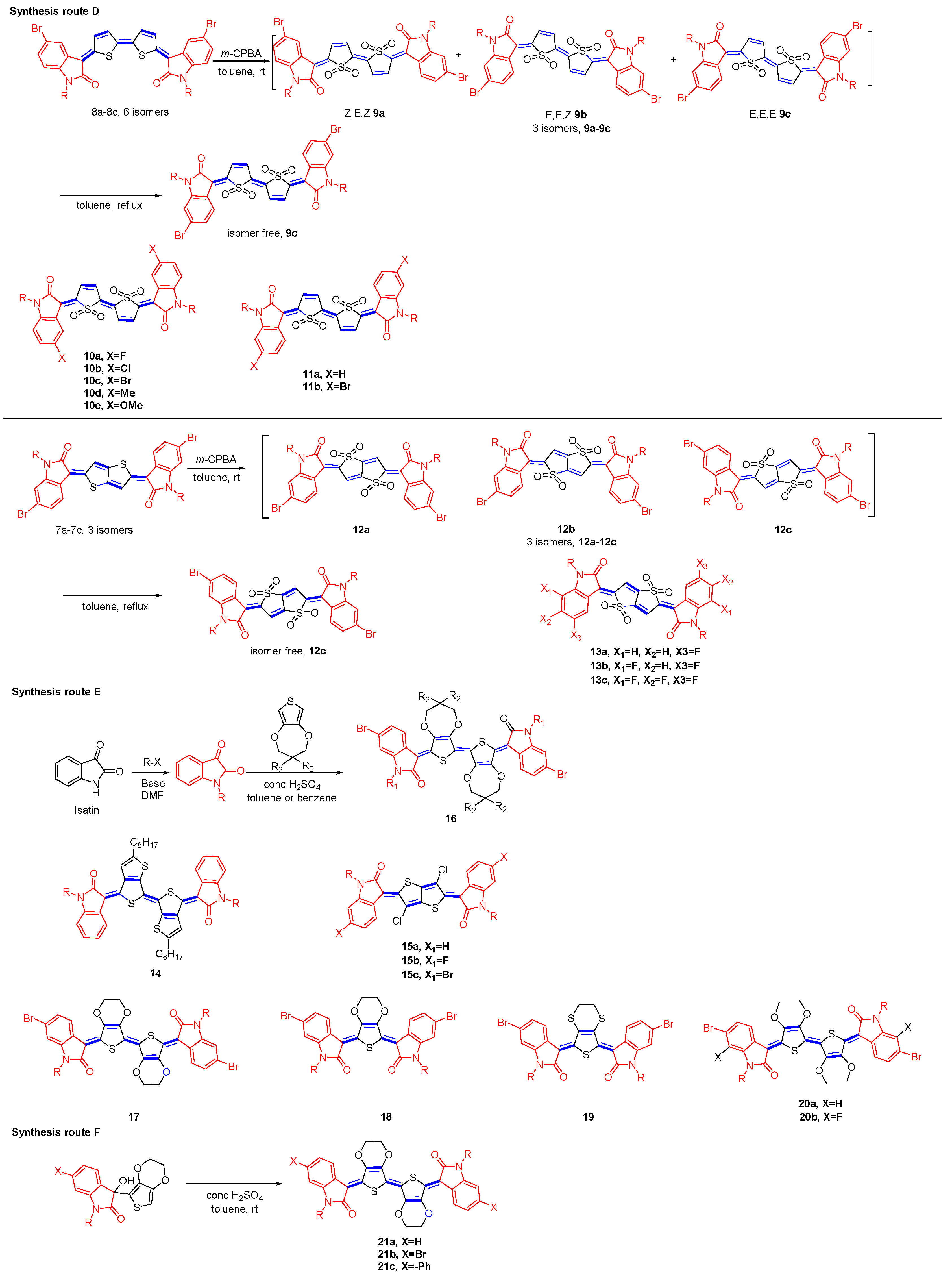
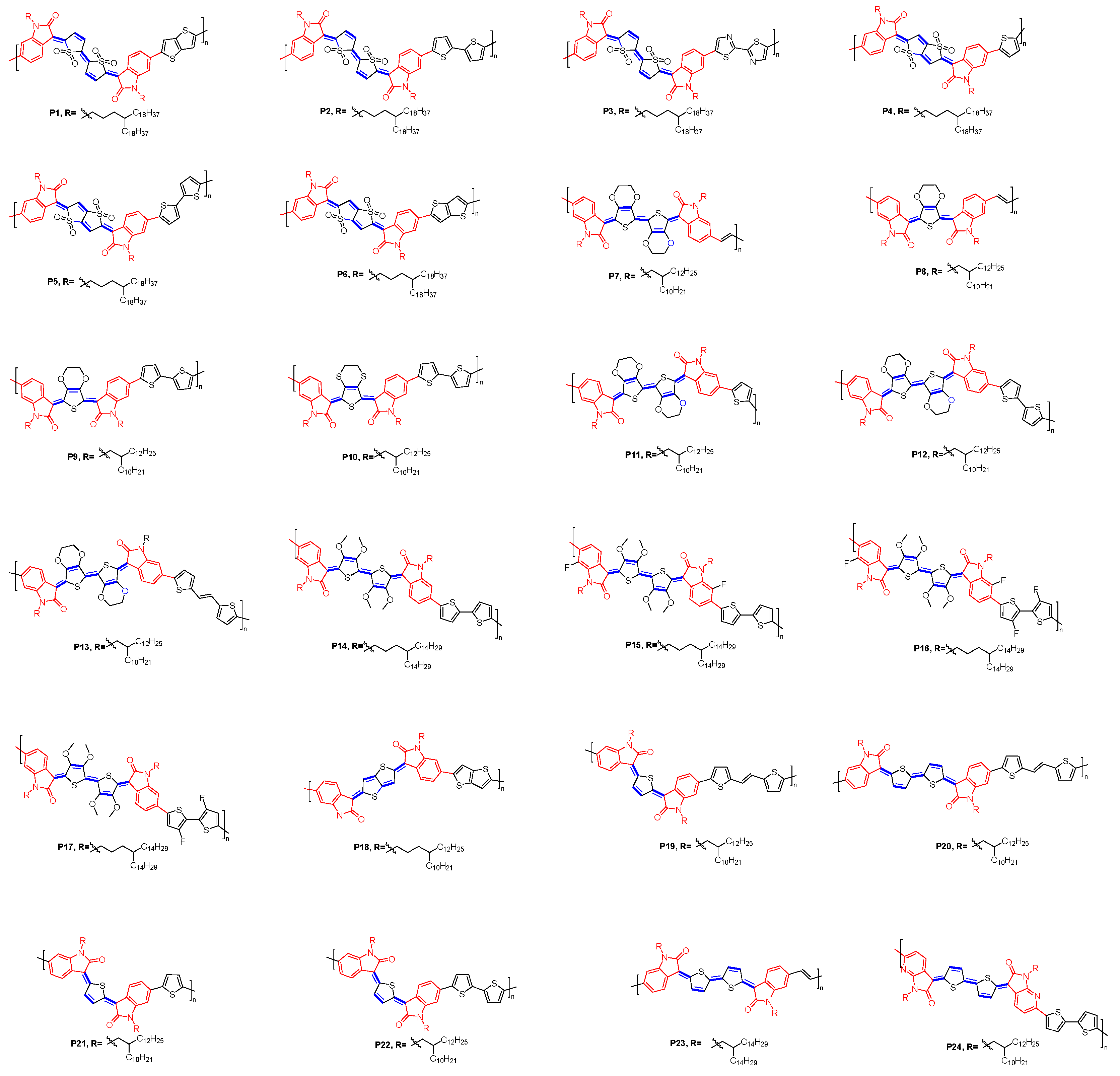

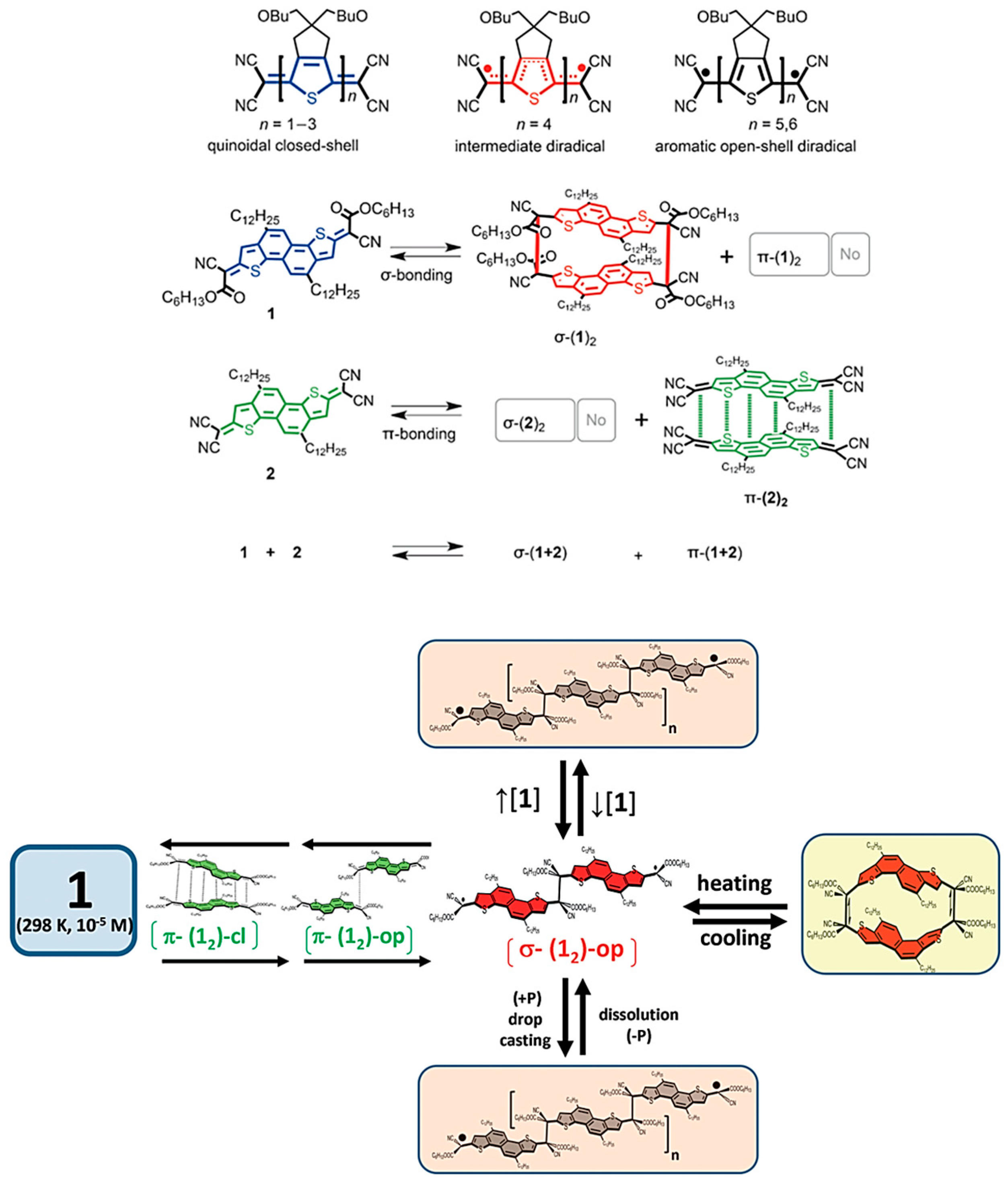

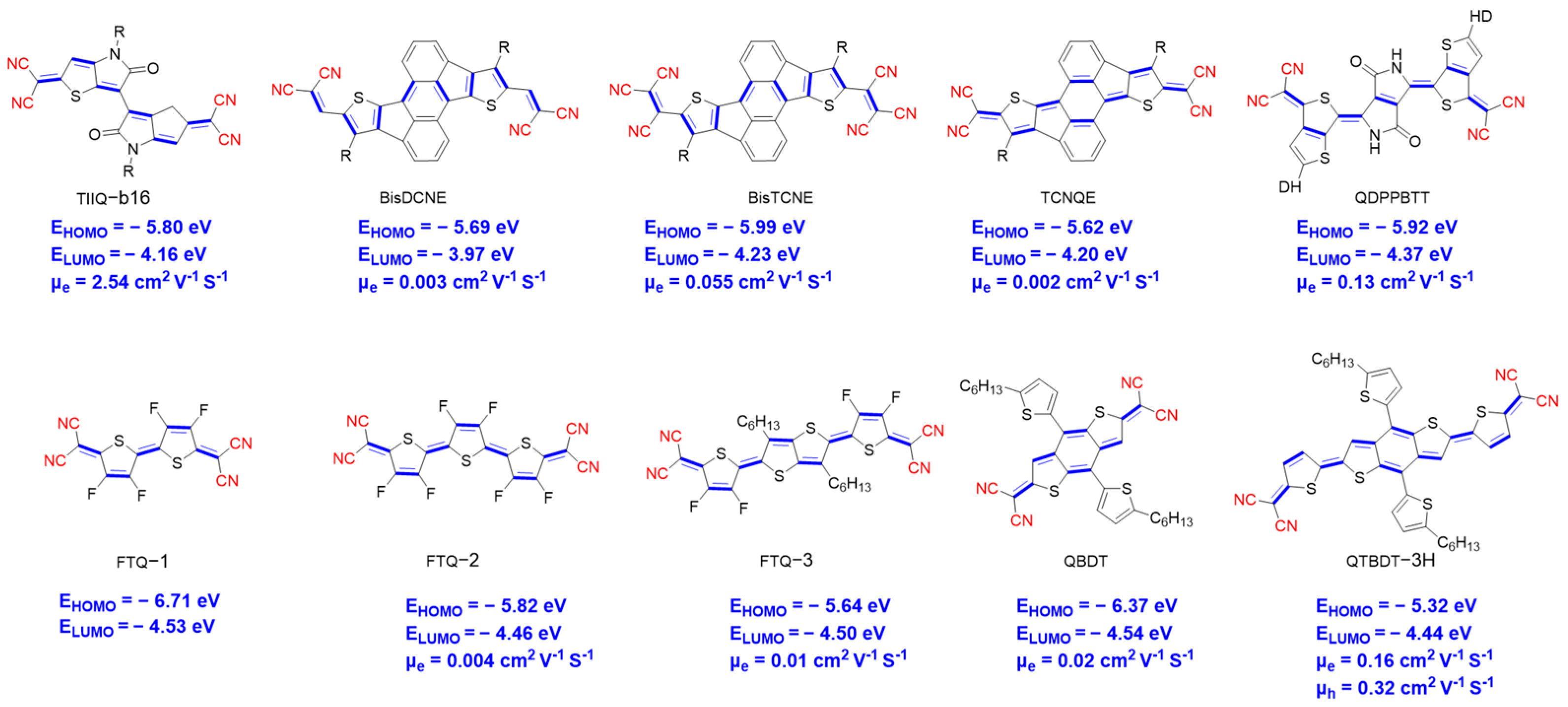
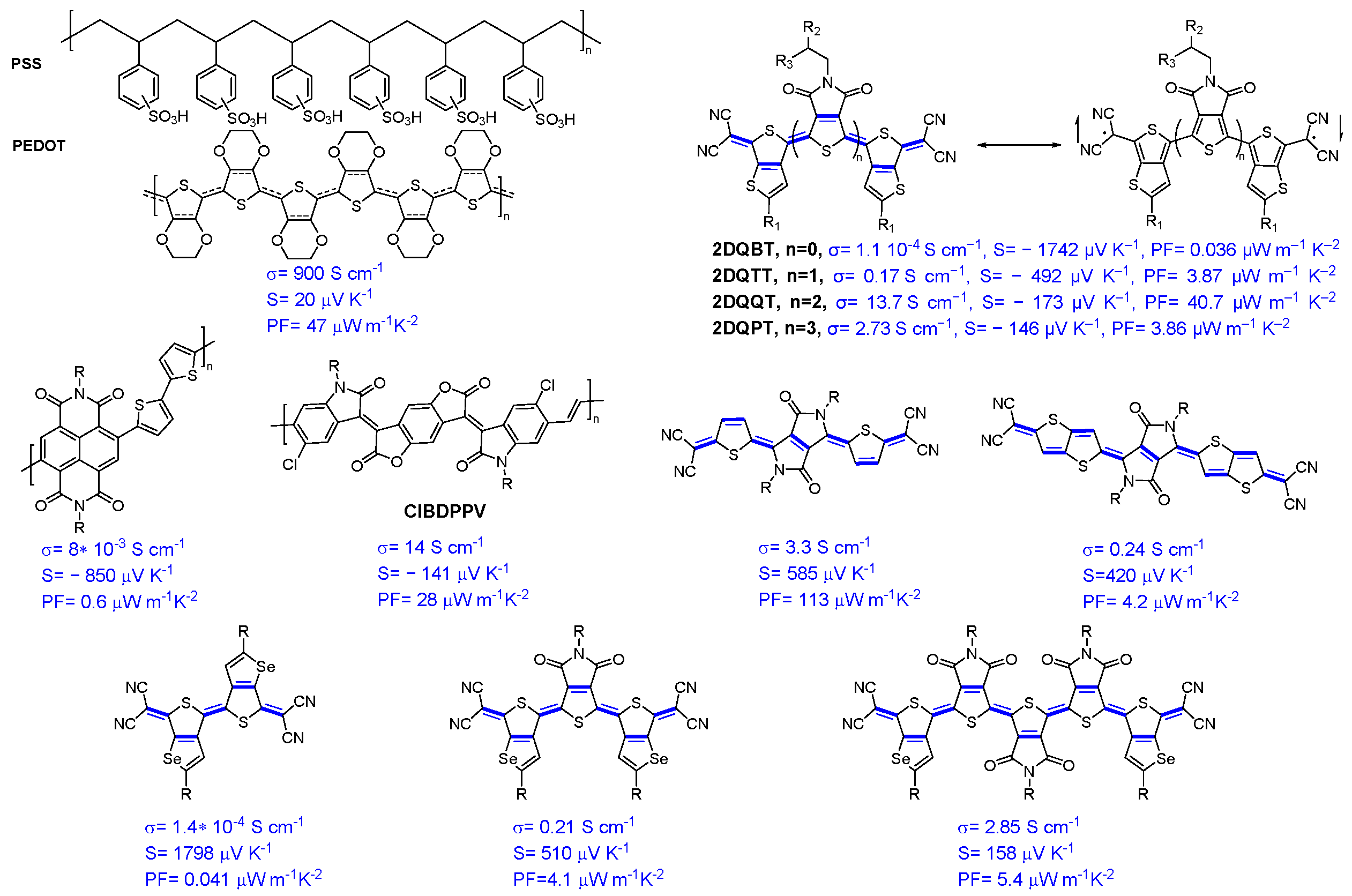
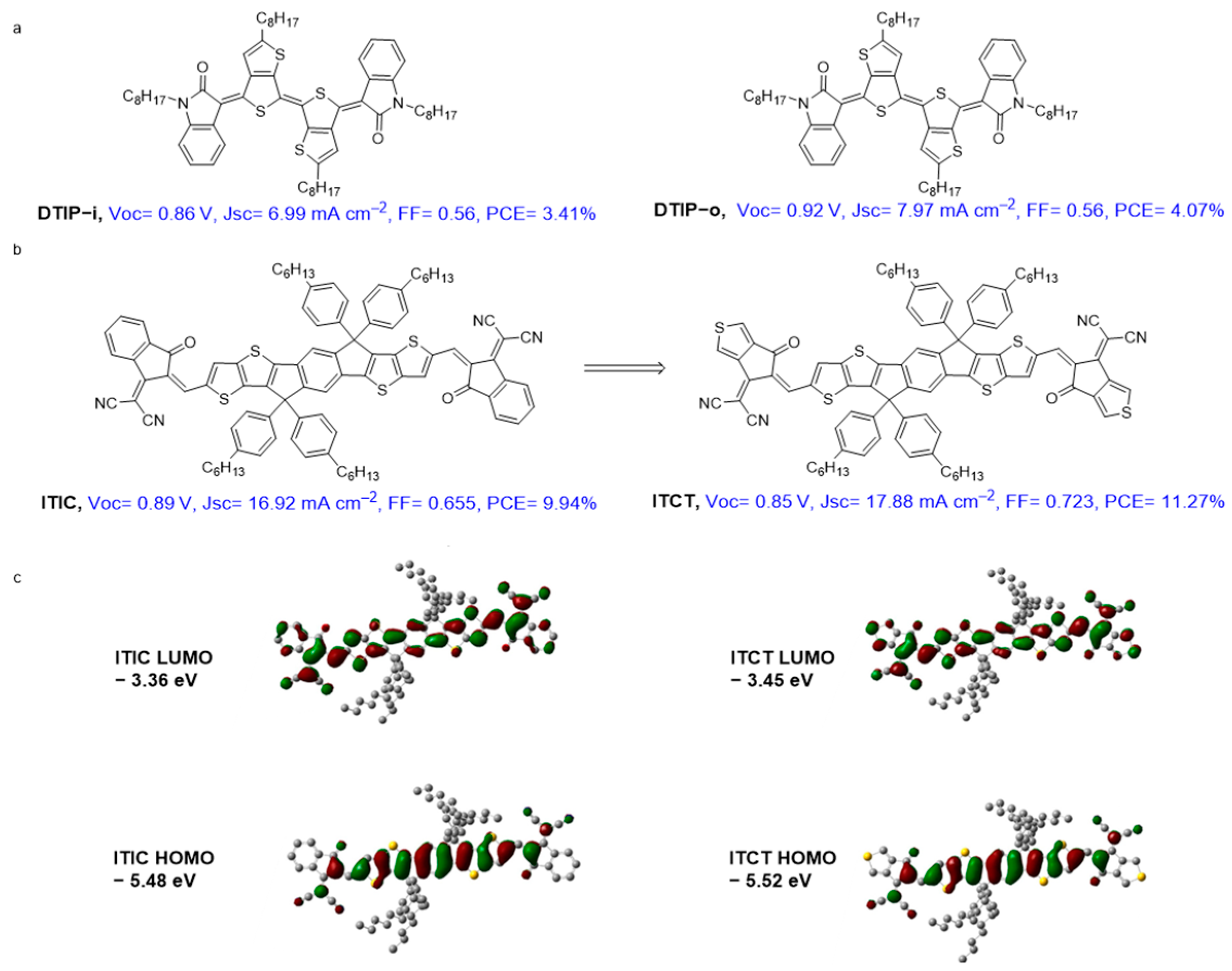
| Materials | λmaxsol (nm) | λmaxfilm (nm) | Eg opt-film (eV) | EHOMO (eV) | ELUMO (eV) | Eg (eV) |
|---|---|---|---|---|---|---|
| 8 | 600 | 650 | 1.55 | −5.41 | −3.86 | 1.55 |
| 9 | 450 | 500 | 1.83 | −5.91 | −4.08 | 1.83 |
| 10c | 479 | 497 | 1.67 | −6.33 | −4.12 | 2.21 |
| 11a | 476 | 491 | 1.74 | −5.85 | −3.99 | 1.86 |
| 11b | 482 | 507 | 1.72 | −6.30 | −4.18 | 2.12 |
| 13a | 427 | 423 | 1.81 | −5.98 | −4.17 | 1.81 |
| 13b | 431 | 427 | 1.85 | −6.10 | −4.25 | 1.85 |
| 13c | 430 | 425 | 1.82 | −6.14 | −4.32 | 1.82 |
| 14 | 665 | 618 | 1.56 | −5.10 | −3.58 | 1.52 |
| 15a | 542 | 467 | 1.65 | −5.47 | −3.97 | 1.54 |
| 15b | 606 | 475 | 1.63 | −5.53 | −4.01 | 1.56 |
| 15c | 620 | 486 | 1.56 | −5.58 | −4.05 | 1.53 |
| 16 | 650 | - | 1.44 | −5.30 | −3.86 | 1.44 |
| 18 | 537 | - | 1.95 | −5.29 | −3.47 | 1.82 |
| 19 | 592 | - | 1.79 | −5.33 | −3.73 | 1.60 |
| 21a | 633 | - | 1.67 | −5.10 | −5.39 | 1.71 |
| 21c | 661 | - | 1.55 | −4.85 | −3.40 | 1.45 |
| Materials | λmaxsol (nm) | λmaxfilm (nm) | Eg opt-film (eV) | EHOMO (eV) | ELUMO (eV) | Eg (eV) |
|---|---|---|---|---|---|---|
| P1 | 710 | 710 | 1.42 | −5.92 | −3.98 | 1.94 |
| P2 | 780 | - | 1.43 | −5.78 | −4.09 | 1.69 |
| P3 | 636 | - | 1.62 | −5.99 | −4.18 | 1.81 |
| P4 | 740 | 723 | 1.48 | −6.00 | −4.04 | 1.96 |
| P5 | 751 | 740 | 1.47 | −5.95 | −4.03 | 1.92 |
| P6 | 758 | 750 | 1.43 | −5.91 | −4.05 | 1.86 |
| P7 | 811 | 821 | 1.17 | −4.59 | −3.62 | 0.96 |
| P8 | 753 | 748 | 1.52 | −5.14 | −3.62 | 1.52 |
| P9 | 670 | 743 | 1.52 | −5.17 | −3.58 | 1.59 |
| P10 | 723 | 787 | 1.36 | −5.17 | −3.70 | 1.47 |
| P11 | 787 | 794 | 1.15 | −4.58 | −3.43 | 1.15 |
| P12 | 746 | 752 | 1.16 | −4.52 | −3.36 | 1.16 |
| P13 | 728 | 712 | 1.18 | −4.50 | −3.32 | 1.18 |
| P14 | 760 | 758 | 1.18 | −5.31 | −3.95 | 1.36 |
| P15 | 984 | 965 | 1.15 | −5.35 | −3.92 | 1.43 |
| P16 | 936 | 930 | 1.13 | −5.43 | −3.97 | 1.46 |
| P17 | 892 | 794 | 1.14 | −5.32 | −3.92 | 1.40 |
| P18 | 876 | 910 | 1.28 | −5.19 | −3.63 | 1.56 |
| P19 | 728 | 778 | 1.34 | −5.22 | −3.43 | 1.79 |
| P20 | 774 | 900 | 1.16 | −5.04 | −3.65 | 1.39 |
| P21 | 768 | 773 | 1.44 | −5.24 | −3.56 | 1.68 |
| P22 | 773 | 769 | 1.45 | −5.11 | −3.55 | 1.56 |
| P23 | 807 | 829 | 1.12 | −5.08 | −3.79 | 1.29 |
| P24 | 845 | 981 | 1.11 | −5.03 | −3.74 | 1.29 |
| Materials | λmax (nm) | Eg opt (eV) | EHOMO (eV) | ELUMO (eV) | OFET structure | μe (cm2/V·s) | Measured Environment |
|---|---|---|---|---|---|---|---|
| P1 | 710 | 1.42 | −5.92 | −3.98 | BGBC | 0.14 | N2 |
| P2 | 765 | 1.43 | −5.78 | −4.09 | BGBC | 0.18 | N2 |
| P3 | 740 | 1.62 | −5.99 | −4.18 | BGBC | 0.016 | N2 |
| P4 | 740 | 1.48 | −6.00 | −4.04 | TGBC | 0.004 | air |
| P5 | 751 | 1.47 | −5.95 | −4.03 | TGBC | 0.38 | air |
| P6 | 758 | 1.43 | −5.91 | −4.04 | TGBC | 0.45 | air |
| Polymers | EHOMO (eV) | ELUMO (eV) | OFET Structure | μh (cm2/V·s) | μe (cm2/V·s) | Measured Environment |
|---|---|---|---|---|---|---|
| P7 | −4.59 | −3.63 | TGBC | 0.12 | N2 | |
| P8 | −5.14 | −3.62 | TGBC | 0.024 | 0.049 | N2 |
| P9 | −5.17 | −3.58 | TGBC | 0.11 | 0.0014 | N2 |
| P10 | −5.17 | −3.70 | TGBC | 0.017 | 0.00092 | N2 |
| P11 | −4.58 | −3.43 | TGBC | 0.043 | N2 | |
| P12 | −4.52 | −3.36 | TGBC | 0.018 | N2 | |
| P13 | −4.50 | −3.32 | TGBC | 0.007 | N2 | |
| P14 | −5.31 | −3.95 | TGBC | 0.10 | N2 | |
| P15 | −5.35 | −3.92 | TGBC | 0.91 | N2 | |
| P16 | −5.43 | −3.97 | TGBC | 2.70 | N2 | |
| P17 | −5.32 | −3.92 | TGBC | 1.35 | N2 | |
| P18 | −5.19 | −3.63 | BGTC | 0.13 | N2 | |
| P19 | −5.22 | −3.43 | TGBC | 2.40 | 0.056 | N2 |
| P20 | −5.04 | −3.65 | TGBC | 0.055 | 0.0015 | N2 |
| P21 | −5.24 | −3.56 | TGBC | 4.82 | 1.11 | N2 |
| P22 | −5.11 | −3.55 | TGBC | 8.09 | 0.74 | N2 |
| P23 | −5.08 | −3.79 | TGBC | 0.52 | 0.53 | N2 |
| P24 | −5.03 | −3.74 | TGBC | 0.35 | 0.46 | N2 |
Disclaimer/Publisher’s Note: The statements, opinions and data contained in all publications are solely those of the individual author(s) and contributor(s) and not of MDPI and/or the editor(s). MDPI and/or the editor(s) disclaim responsibility for any injury to people or property resulting from any ideas, methods, instructions or products referred to in the content. |
© 2023 by the authors. Licensee MDPI, Basel, Switzerland. This article is an open access article distributed under the terms and conditions of the Creative Commons Attribution (CC BY) license (https://creativecommons.org/licenses/by/4.0/).
Share and Cite
Ren, S.; Yassar, A. Recent Research Progress in Indophenine-Based-Functional Materials: Design, Synthesis, and Optoelectronic Applications. Materials 2023, 16, 2474. https://doi.org/10.3390/ma16062474
Ren S, Yassar A. Recent Research Progress in Indophenine-Based-Functional Materials: Design, Synthesis, and Optoelectronic Applications. Materials. 2023; 16(6):2474. https://doi.org/10.3390/ma16062474
Chicago/Turabian StyleRen, Shiwei, and Abderrahim Yassar. 2023. "Recent Research Progress in Indophenine-Based-Functional Materials: Design, Synthesis, and Optoelectronic Applications" Materials 16, no. 6: 2474. https://doi.org/10.3390/ma16062474





